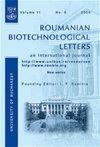In silico identification of cis-Regulatory elements and their functional annotations from assembled ESTs of Artemisia annua L. involved in abiotic stress signaling
引用次数: 1
Abstract
Salt stress is a common side-effect in plants impacted on plant growth, metabolism and productivity. A. annua L. is one of the well-known antimalarial plants, biosynthesized artemisinin in its leaf, now introduced in all-over the world. In this article, we have analyzed the A. annua L. ESTs under salt stress and predicted cis-regulatory elements, roles in abiotic stress signaling. Further, the predicted abiotic stress responsive factors were analyzed in order to their function annotations as compare to the genome of Arabidopsis thaliana. 11 EST-contigs assembled from 127 were 29 signals elements were identified by CAP3 program. In order to evaluate accuracy of the identified factors, gene ontology functions were performed. GOBP analysis enriched the genes (85.71%) as the response to abiotic signaling. The co-expression analysis was revealed by gene investigators and String 10.0, these factors-oriented genes had at least 0.40 correlations and 0.7 mutual connection. In projected PPI network, the recognized factors belong to plant hormone signaling and diterpene pathways. These factors (ABF1, APX CCC1, CPK6, JAZ1, MYC2) introduced as candidate genes responsive factors could be overexpressed in A. annua L. plants either alone or in a shuttle may led the good metabolism and higher artemisinin content.黄花蒿(Artemisia annua L.)非生物胁迫信号通路的顺式调控元件及其功能标记
盐胁迫是影响植物生长、代谢和生产力的常见副作用。黄花蒿(a.a annua L.)是一种著名的抗疟植物,其叶片中含有生物合成的青蒿素,现已在世界各地引种。本文分析了盐胁迫下黄花蒿的est序列,并预测了其顺式调控元件在非生物胁迫信号传导中的作用。此外,对拟南芥非生物胁迫响应因子的预测结果进行了分析,并与拟南芥基因组进行了功能注释。从127个EST-contigs中,通过CAP3程序鉴定出29个信号元件。为了评估识别因子的准确性,进行了基因本体功能。GOBP分析丰富了基因(85.71%)作为对非生物信号的应答。基因研究者和String 10.0的共表达分析显示,这些因子导向基因的相关系数至少为0.40,相互连接系数为0.7。在预测的PPI网络中,识别的因子属于植物激素信号通路和二萜途径。ABF1、APX、CCC1、CPK6、JAZ1、MYC2作为候选基因响应因子在黄花蒿中均有过表达,可能导致黄花蒿代谢良好,青蒿素含量较高。
本文章由计算机程序翻译,如有差异,请以英文原文为准。
求助全文
约1分钟内获得全文
求助全文

 求助内容:
求助内容: 应助结果提醒方式:
应助结果提醒方式:


